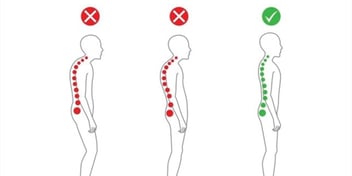Discover effective exercises that can help relieve neck pain caused by work or daily activities.
Understanding Neck Pain
Neck pain is a common ailment that many people experience, especially those who work desk jobs or engage in activities that require them to sit for long periods of time. It can be caused by a variety of factors, including poor posture, muscle strain, and stress. Understanding the underlying causes of neck pain is crucial in finding effective solutions to alleviate discomfort and prevent further issues.
One possible cause of neck pain is poor posture. Sitting or standing with your head and neck in a forward position for extended periods of time can put strain on the muscles and ligaments in your neck, leading to pain and stiffness. Additionally, constantly looking down at screens, such as smartphones or laptops, can contribute to neck pain.
Muscle strain is another common cause of neck pain. This can occur when you engage in activities that require repetitive neck movements or when you hold your neck in an awkward position for a prolonged period. For example, constantly looking up or down while painting a ceiling or working under a car can strain the muscles in your neck.
Stress is also a significant contributor to neck pain. When you're stressed, your muscles tend to tense up, including those in your neck and shoulders. This can lead to muscle imbalances and discomfort in the neck region. Finding ways to manage stress, such as practicing relaxation techniques or engaging in regular exercise, can help alleviate neck pain caused by stress.
By understanding the various causes of neck pain, you can take steps to address and prevent it. Incorporating simple exercises and lifestyle changes into your routine can provide relief and improve your overall neck health.
Causes of Neck Pain
Neck pain can have several causes, ranging from minor issues to more serious conditions. Some common causes of neck pain include muscle strains, poor posture, herniated discs, osteoarthritis, and spinal stenosis.
-
Muscle strains are one of the most common causes of neck pain. They can occur due to activities that involve repetitive neck movements or sudden jerking motions. Poor posture, especially when sitting or standing for long periods with your head and neck in a forward position, can also strain the muscles in your neck.
-
Herniated discs can cause neck pain when the soft, gel-like center of a spinal disc bulges or ruptures, putting pressure on nearby nerves. This can result in pain, numbness, and weakness in the neck and shoulder region.
-
Osteoarthritis, a degenerative joint disease, can affect the neck and cause pain and stiffness. It occurs when the cartilage that cushions the joints wears down over time, leading to bone rubbing against bone.
-
Spinal stenosis is a condition in which the spinal canal narrows, putting pressure on the spinal cord and nerves. This can cause pain, numbness, and weakness in the neck and other parts of the body.
Understanding the specific cause of your neck pain is important in determining the most appropriate treatment and management strategies. If you're experiencing severe or persistent neck pain, it's advisable to consult a healthcare professional for an accurate diagnosis and personalized treatment plan.
Importance of Exercise for Neck Pain Relief
Exercise plays a crucial role in relieving neck pain and promoting overall neck health. Regular physical activity helps strengthen the muscles that support the neck, improves flexibility, and enhances blood circulation to the area.
When you engage in exercises that target the neck and upper back muscles, you can alleviate tension, reduce muscle imbalances, and enhance posture. This can help relieve existing neck pain and prevent future discomfort.
Additionally, exercise promotes the release of endorphins, which are natural pain-relieving chemicals produced by the body. These endorphins can help reduce pain and improve mood, making exercise an effective non-pharmacological approach to managing neck pain.
It's important to note that not all exercises are suitable for everyone experiencing neck pain. It's advisable to consult a healthcare professional or a certified fitness trainer before starting any exercise routine, especially if you have an underlying medical condition or a history of neck injuries.
Incorporating a combination of stretching, strengthening, and aerobic exercises into your routine can provide the best results for neck pain relief. Remember to start slowly, listen to your body, and gradually increase the intensity and duration of your workouts as you build strength and flexibility.
Effective Neck Pain Relief Exercises
There are several effective exercises that can help relieve neck pain and improve neck mobility. Here are a few examples:
-
Neck Stretches: Gently tilt your head to one side, bringing your ear towards your shoulder. Hold for a few seconds, then repeat on the other side. You can also tilt your head forward, backward, and rotate it gently to stretch different neck muscles.
-
Neck Isometrics: Place your hand on the side of your head and press your head against your hand, resisting the movement. Hold for a few seconds, then repeat on the other side. This exercise helps strengthen the neck muscles.
-
Shoulder Rolls: Roll your shoulders forward and backward in a circular motion. This exercise helps relieve tension in the neck and upper back muscles.
-
Chin Tucks: Sit or stand with your back straight. Gently tuck your chin inwards, as if you're creating a double chin. Hold for a few seconds, then release. This exercise helps improve posture and strengthen the muscles at the front of your neck.
-
Upper Back Extension: Stand with your hands on your hips. Gently arch your upper back backward, keeping your neck in a neutral position. Hold for a few seconds, then return to the starting position. This exercise helps improve upper back mobility.
Remember to perform these exercises with proper form and control. Start with a few repetitions and gradually increase as tolerated. If you experience any pain or discomfort during or after exercise, stop immediately and consult a healthcare professional.
In addition to these exercises, incorporating regular breaks and ergonomic adjustments into your work routine can also help prevent neck pain. Avoid holding your neck in a static position for too long, take short breaks to stretch and move around, and ensure that your workstation is properly set up to promote good posture.
Incorporating Neck Strengthening Exercises into Your Routine
Neck strengthening exercises can play a vital role in preventing and managing neck pain. Strengthening the muscles that support your neck can help improve stability, reduce the risk of injury, and alleviate discomfort.
Here are a few neck-strengthening exercises you can incorporate into your routine:
- Neck Retraction: Sit or stand with your back straight. Gently retract your neck by pulling your chin inwards, as if you're trying to make a double chin. Hold for a few seconds, then release. Repeat multiple times.
- Resistance Band Exercises: Attach a resistance band to a stable object at chest height. Hold the other end of the band with both hands and bring your hands towards your chest, keeping your neck in a neutral position. Slowly return to the starting position. Repeat for several repetitions.
- Neck Bridges: Lie on your back with your knees bent and feet flat on the floor. Place your hands on the floor beside your head, fingers pointing towards your shoulders. Push through your hands and lift your head and shoulders off the floor, keeping your neck aligned with your spine. Hold for a few seconds, then lower back down. Repeat for several repetitions.
- Neck Resistance Exercises: Place your hand on your forehead and gently push your head forward, resisting the movement with your neck muscles. Hold for a few seconds, then release. Repeat with your hand on the back of your head, pushing backward, and on the side of your head, pushing sideways. Perform multiple repetitions on each side.
It's important to start with light resistance or bodyweight exercises and gradually increase as your neck strength improves. Remember to maintain proper form and avoid straining or jerking movements.
Incorporating these neck strengthening exercises into your routine, along with regular stretching and aerobic exercises, can help improve neck stability and reduce the risk of pain and injury. As always, consult a healthcare professional or a certified fitness trainer before starting any new exercise program.





-2.webp?width=352&name=Blog%20Graphic%20(1)-2.webp)
Leave a Comment